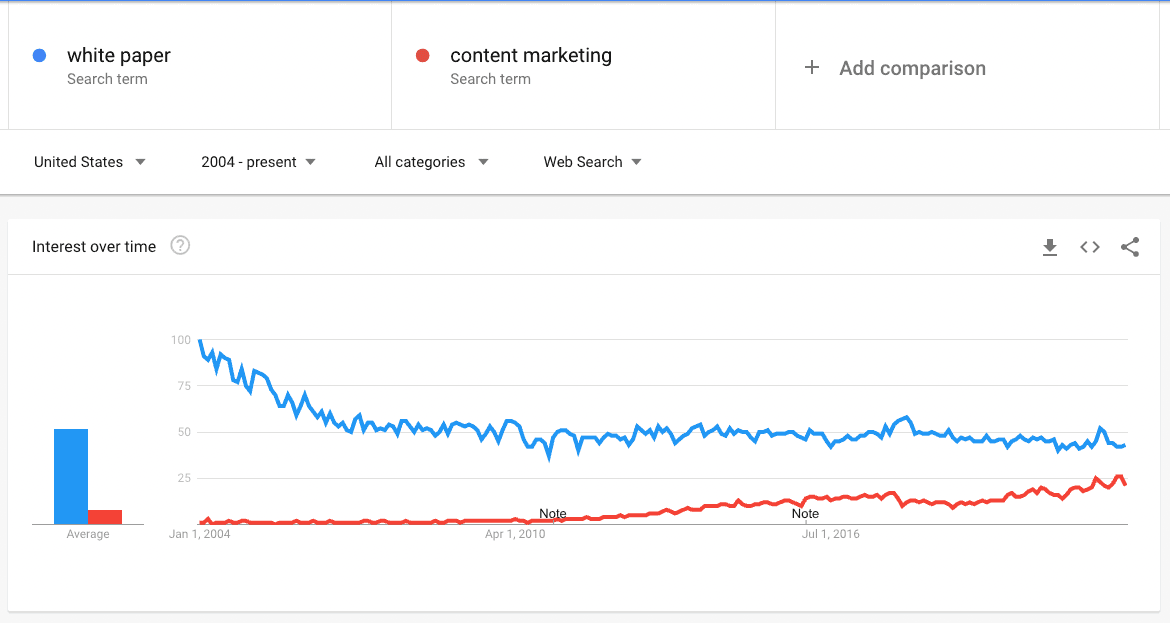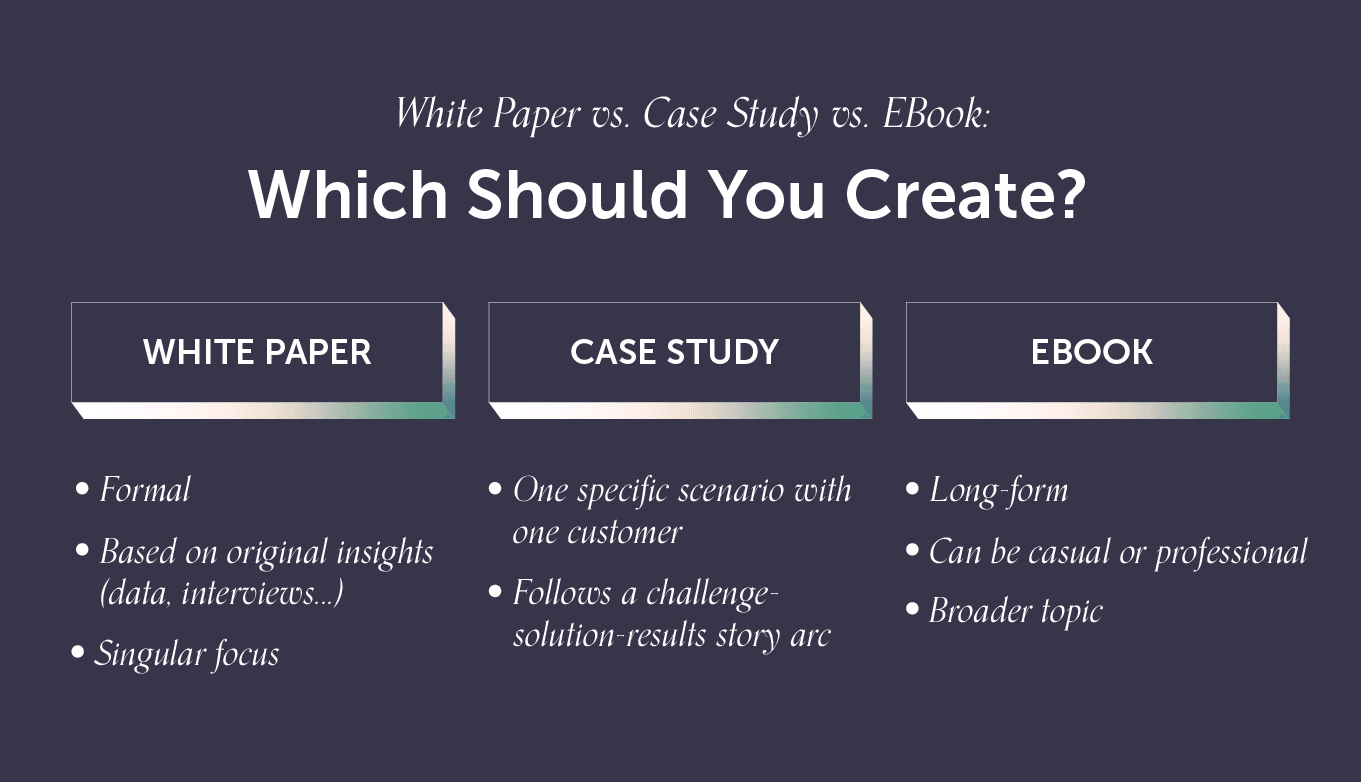
What is the purpose of white papers?
White papers build trust with a casual reader, put you on the map for a target customer researching their options, and make every stage of your sales funnel more efficient.
What Does “White Paper” Mean?
Definition Of White Papers
A white paper is a marketing asset that argues a specific position or solves a problem for your audience. It’s a document that helps you establish topical authority and share original insights, data, and expertise.
White papers are more complex and advanced than other marketing formats like articles or emails. They tend to have longer content that covers a topic in-depth through extensive research.
Companies, brands, and nonprofits package white papers into PDF documents and offer them in exchange for an email address (and often more information, like company size, job role, and location). This opportunity makes them a great
lead magnet.
White papers have been around for decades—
even longer than content marketing, which white papers are part of:
 Source
Source
White papers can be a great tool in every stage of your
sales funnel. At the top of the funnel, you can focus on in-depth education; for prospects later in the funnel, you can share practical, action-driven tips.
Here are examples of both kinds of white papers:
Be sure to consider other downloadable content formats based on your audience and goals.
Here’s what to keep in mind about white papers, case studies, and ebooks:

Best use cases for white papers:
- Formal
- Based on original insights (data, interviews, etc.)
- Singular focus
Best use cases for case studies:
- One specific scenario with one customer
- Follows a challenge-solutions-results story arc
Best use cases for ebooks:
- Long-form
- Can be casual or professional
- Broader topic
Types Of White Papers
What is considered a white paper? There are plenty of examples for you to take inspiration from.
White papers can take different forms and help you achieve a range of objectives. Here are the types to consider
when writing one of your own.
1. Technical White Paper
 Source
Source
A technical white paper describes how technology solves a specific problem. This white paper type usually focuses on a specific product or a technical process behind a solution.
Oracle’s white paper on deploying an Exadata DB system is a good example of this.
Technical white papers are often part of content hubs like a tech documentation library or a security center. They’re aimed at a tech-savvy audience. These white papers feature elements like diagrams, tables, screenshots, and flowcharts to help convey the most complex points.
2. Business Benefits White Paper
 Source
Source
Business benefits white papers target a non-technical audience. Unlike technical white papers, which show
how certain technology works, a business benefits white paper makes a business case for a certain product or technology. Nextiva’s
VoIP considerations for small businesses white paper is a great example.
These types of white papers aim to direct and simplify the reader’s process of researching and buying a solution for their problem. This tactic makes them a powerful asset in the middle of the funnel, as this is when your potential buyer is comparing different types of options.
3. Product Comparison White Paper
 Source
Source
A product comparison white paper targets readers who know the type of product they’re buying, but haven’t yet picked a vendor to buy from.
You can use this format to compare your product and its features with those of your competitors. If you’re a service provider, you can do what dotSource, a digital agency, did with their
Selecting Marketing Automation Systems white paper: compare products for a problem you solve, which positions you as the ideal partner to hire.
4. How-To / Problem-Solving White Paper
 Source
Source
Is there a problem many people in your industry struggle with? If you know the solution to the problem, and it’s deeper and more complex than what you’d cover in a regular blog post, a problem-solving white paper is a perfect format to use.
This how-to white paper is ideal for lead generation at the top of your funnel, but your sales team can use it in conversations with prospects and customers at all stages as it positions you as the expert with the right experience. A great example of such a white paper is FreshBooks’
6 Smart Ways To Future-Proof Your Business.
5. Thought Leadership White Paper
 Source
Source
A thought leadership white paper allows you to position an original concept within your market. This white paper type typically challenges a commonly accepted belief or way of solving a problem, and it uses unique data and experience to introduce a new approach.
Here’s an example of this you might recognize:
Inbound Marketing by Brian Halligan and Dharmesh Shah. While it was a book rather than a white paper, this piece of original work brought us an entirely new way of marketing our businesses and ideas.
You can introduce a new approach—
your approach—to tackling your audience’s pain points through thought leadership white papers.
6. Educational White Paper
 Source
Source
An educational white paper gives you the chance to teach readers about a subject related to your business. Since white papers have such an emphasis on research, you can dig deep into academic and professional sources for these documents.
For instance, SynergyLabs, a pet care goods manufacturer, create white papers on the scientific data behind different health solutions. Their
Scientific Data: Hot Spot & Itch Relief white paper explores scientific papers on using lidocaine and hydrocortisone for skin inflammation in animals.
By sharing this information on the scientifically supported benefits of certain ingredients, they inform the reader and promote their products with those ingredients.
7. Market Research White Paper
 Source
Source
Market research white papers provide statistics and insights on a market or industry. If you’ve ever seen a white paper titled “The State Of…”, it probably falls in this category.
Pipedrive offers insights into the sales industry through its
State of Sales Report. These reports explain salespeople’s habits and tactics to help readers get a competitive edge in the market.
If you have the resources to perform the research needed for a market research white paper, your customers could look to you for a competitive edge, too.
8. Visionary White Paper
 Source
Source
Visionary white papers offer a vision of an industry’s future based on expert knowledge and research.
Shopify combines this format with the market research format in its yearly
Future of Commerce Trend Report. The 2022 edition shares market research statistics, then suggests best practices for the industry’s future based on those numbers.
Professionals in retail and ecommerce count on these reports every year for up-to-date statistics, making Shopify a thought leader in the space.
(Keep in mind that not every “Future Of…” white paper is a visionary paper—market research papers can use that title, too.)
White Paper FAQs
What Is The History Of White Papers?
In their various forms, white papers have always given professionals guidance through in-depth research. The term originally referred to government documents, but now it also applies to the business reports we know today.
The British government first used the phrase “
white paper” in 1920. Then, Gertrude Bell presented her report “Review of the Civil Administration of Mesopotamia" to British Parliament.
A few years later in 1922, the
Churchill White Paper, a U.K. government report on Palestine, popularized the term. From then on, other governments started calling similar reports white papers.
Move forward 70 years, and businesses began to refer to certain promotional documents as white papers
in the early 1990s.
Why Is A White Paper Called A White Paper?
The modern term for “white paper” comes from two sources:
- According to Stanford Law School, people started using the phrase when governments color-coded papers based on distribution. White papers were open for public access.
- A TechTarget article says that multiple versions of Webster’s Dictionary define a white paper as a blue book’s shorter counterpart. While blue books were extensive reports bound in blue, white papers were briefer publications with white binding — the same color as the text.
 What is the purpose of white papers?
White papers build trust with a casual reader, put you on the map for a target customer researching their options, and make every stage of your sales funnel more efficient.
What is the purpose of white papers?
White papers build trust with a casual reader, put you on the map for a target customer researching their options, and make every stage of your sales funnel more efficient.
 Source
White papers can be a great tool in every stage of your sales funnel. At the top of the funnel, you can focus on in-depth education; for prospects later in the funnel, you can share practical, action-driven tips.
Here are examples of both kinds of white papers:
Source
White papers can be a great tool in every stage of your sales funnel. At the top of the funnel, you can focus on in-depth education; for prospects later in the funnel, you can share practical, action-driven tips.
Here are examples of both kinds of white papers:
 Best use cases for white papers:
Best use cases for white papers:
 Source
A technical white paper describes how technology solves a specific problem. This white paper type usually focuses on a specific product or a technical process behind a solution. Oracle’s white paper on deploying an Exadata DB system is a good example of this.
Technical white papers are often part of content hubs like a tech documentation library or a security center. They’re aimed at a tech-savvy audience. These white papers feature elements like diagrams, tables, screenshots, and flowcharts to help convey the most complex points.
Source
A technical white paper describes how technology solves a specific problem. This white paper type usually focuses on a specific product or a technical process behind a solution. Oracle’s white paper on deploying an Exadata DB system is a good example of this.
Technical white papers are often part of content hubs like a tech documentation library or a security center. They’re aimed at a tech-savvy audience. These white papers feature elements like diagrams, tables, screenshots, and flowcharts to help convey the most complex points.
 Source
Business benefits white papers target a non-technical audience. Unlike technical white papers, which show how certain technology works, a business benefits white paper makes a business case for a certain product or technology. Nextiva’s VoIP considerations for small businesses white paper is a great example.
These types of white papers aim to direct and simplify the reader’s process of researching and buying a solution for their problem. This tactic makes them a powerful asset in the middle of the funnel, as this is when your potential buyer is comparing different types of options.
Source
Business benefits white papers target a non-technical audience. Unlike technical white papers, which show how certain technology works, a business benefits white paper makes a business case for a certain product or technology. Nextiva’s VoIP considerations for small businesses white paper is a great example.
These types of white papers aim to direct and simplify the reader’s process of researching and buying a solution for their problem. This tactic makes them a powerful asset in the middle of the funnel, as this is when your potential buyer is comparing different types of options.
 Source
A product comparison white paper targets readers who know the type of product they’re buying, but haven’t yet picked a vendor to buy from.
You can use this format to compare your product and its features with those of your competitors. If you’re a service provider, you can do what dotSource, a digital agency, did with their Selecting Marketing Automation Systems white paper: compare products for a problem you solve, which positions you as the ideal partner to hire.
Source
A product comparison white paper targets readers who know the type of product they’re buying, but haven’t yet picked a vendor to buy from.
You can use this format to compare your product and its features with those of your competitors. If you’re a service provider, you can do what dotSource, a digital agency, did with their Selecting Marketing Automation Systems white paper: compare products for a problem you solve, which positions you as the ideal partner to hire.
 Source
Is there a problem many people in your industry struggle with? If you know the solution to the problem, and it’s deeper and more complex than what you’d cover in a regular blog post, a problem-solving white paper is a perfect format to use.
This how-to white paper is ideal for lead generation at the top of your funnel, but your sales team can use it in conversations with prospects and customers at all stages as it positions you as the expert with the right experience. A great example of such a white paper is FreshBooks’ 6 Smart Ways To Future-Proof Your Business.
Source
Is there a problem many people in your industry struggle with? If you know the solution to the problem, and it’s deeper and more complex than what you’d cover in a regular blog post, a problem-solving white paper is a perfect format to use.
This how-to white paper is ideal for lead generation at the top of your funnel, but your sales team can use it in conversations with prospects and customers at all stages as it positions you as the expert with the right experience. A great example of such a white paper is FreshBooks’ 6 Smart Ways To Future-Proof Your Business.
 Source
A thought leadership white paper allows you to position an original concept within your market. This white paper type typically challenges a commonly accepted belief or way of solving a problem, and it uses unique data and experience to introduce a new approach.
Here’s an example of this you might recognize: Inbound Marketing by Brian Halligan and Dharmesh Shah. While it was a book rather than a white paper, this piece of original work brought us an entirely new way of marketing our businesses and ideas.
You can introduce a new approach—your approach—to tackling your audience’s pain points through thought leadership white papers.
Source
A thought leadership white paper allows you to position an original concept within your market. This white paper type typically challenges a commonly accepted belief or way of solving a problem, and it uses unique data and experience to introduce a new approach.
Here’s an example of this you might recognize: Inbound Marketing by Brian Halligan and Dharmesh Shah. While it was a book rather than a white paper, this piece of original work brought us an entirely new way of marketing our businesses and ideas.
You can introduce a new approach—your approach—to tackling your audience’s pain points through thought leadership white papers.
 Source
An educational white paper gives you the chance to teach readers about a subject related to your business. Since white papers have such an emphasis on research, you can dig deep into academic and professional sources for these documents.
For instance, SynergyLabs, a pet care goods manufacturer, create white papers on the scientific data behind different health solutions. Their Scientific Data: Hot Spot & Itch Relief white paper explores scientific papers on using lidocaine and hydrocortisone for skin inflammation in animals.
By sharing this information on the scientifically supported benefits of certain ingredients, they inform the reader and promote their products with those ingredients.
Source
An educational white paper gives you the chance to teach readers about a subject related to your business. Since white papers have such an emphasis on research, you can dig deep into academic and professional sources for these documents.
For instance, SynergyLabs, a pet care goods manufacturer, create white papers on the scientific data behind different health solutions. Their Scientific Data: Hot Spot & Itch Relief white paper explores scientific papers on using lidocaine and hydrocortisone for skin inflammation in animals.
By sharing this information on the scientifically supported benefits of certain ingredients, they inform the reader and promote their products with those ingredients.
 Source
Market research white papers provide statistics and insights on a market or industry. If you’ve ever seen a white paper titled “The State Of…”, it probably falls in this category.
Pipedrive offers insights into the sales industry through its State of Sales Report. These reports explain salespeople’s habits and tactics to help readers get a competitive edge in the market.
If you have the resources to perform the research needed for a market research white paper, your customers could look to you for a competitive edge, too.
Source
Market research white papers provide statistics and insights on a market or industry. If you’ve ever seen a white paper titled “The State Of…”, it probably falls in this category.
Pipedrive offers insights into the sales industry through its State of Sales Report. These reports explain salespeople’s habits and tactics to help readers get a competitive edge in the market.
If you have the resources to perform the research needed for a market research white paper, your customers could look to you for a competitive edge, too.
 Source
Visionary white papers offer a vision of an industry’s future based on expert knowledge and research.
Shopify combines this format with the market research format in its yearly Future of Commerce Trend Report. The 2022 edition shares market research statistics, then suggests best practices for the industry’s future based on those numbers.
Professionals in retail and ecommerce count on these reports every year for up-to-date statistics, making Shopify a thought leader in the space.
(Keep in mind that not every “Future Of…” white paper is a visionary paper—market research papers can use that title, too.)
Source
Visionary white papers offer a vision of an industry’s future based on expert knowledge and research.
Shopify combines this format with the market research format in its yearly Future of Commerce Trend Report. The 2022 edition shares market research statistics, then suggests best practices for the industry’s future based on those numbers.
Professionals in retail and ecommerce count on these reports every year for up-to-date statistics, making Shopify a thought leader in the space.
(Keep in mind that not every “Future Of…” white paper is a visionary paper—market research papers can use that title, too.)


